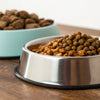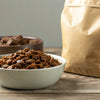How Much Dry Food to Feed a Dog Per Day: A Comprehensive Guide for Pet Owners
- Houndsy
Table of Contents
- Introduction
- Understanding Your Dog's Nutritional Needs
- Calculating the Right Amount of Food
- Factors to Consider
- Monitoring Your Dog's Health and Weight
- Feeding Tips and Strategies
- Conclusion
Introduction
Did you know that an estimated 59% of dogs in the United States are overweight or obese? This alarming statistic highlights the importance of understanding how much dry food to feed a dog per day. As responsible pet owners, we want our furry companions to thrive and enjoy a healthy, happy life. However, determining the right portion size can be a challenging task, given the various factors that influence a dog's dietary needs.
In this blog post, we will delve into the intricacies of dog nutrition, exploring the essential aspects of feeding your dog the right amount of dry food. We will discuss factors such as age, breed, activity level, and overall health status that affect feeding amounts. You can expect to learn how to read dog food labels effectively, utilize feeding charts, and recognize signs of underfeeding and overfeeding.
By the end of this guide, you will have a comprehensive understanding of how much dry food to feed your dog per day and strategies to ensure your pup maintains a healthy weight. Let's embark on this journey to elevate our pet care experience together!
Understanding Your Dog's Nutritional Needs
The Importance of a Balanced Diet
At the core of your dog's health lies a well-balanced diet that meets their unique nutritional requirements. Dogs require a combination of proteins, fats, carbohydrates, vitamins, and minerals to support their growth, energy levels, and overall well-being. Here are the key components of a dog's diet:
- Proteins: Essential for muscle growth, repair, and immune function.
- Fats: Provide energy and aid in the absorption of fat-soluble vitamins.
- Carbohydrates: Offer a source of energy and promote digestive health through fiber.
- Vitamins and Minerals: Support various bodily functions, including immune health and bone development.
Factors Influencing Daily Food Intake
When considering how much dry food to feed your dog per day, several factors come into play:
- Age: Puppies, adults, and senior dogs have varying nutritional requirements that change as they grow and age.
- Size: Larger breeds typically require more food than smaller breeds, as their caloric needs differ based on body weight.
- Activity Level: Active dogs need more calories to sustain their energy levels compared to less active dogs.
- Health Status: Dogs with specific health conditions may require tailored diets that affect their caloric intake.
- Body Condition Score (BCS): Assessing whether your dog is underweight, at a healthy weight, or overweight can help guide food portions.
Calculating the Right Amount of Food
Reading Dog Food Labels
To determine how much dry food to feed your dog, start by looking at the feeding guidelines provided on the packaging of your dog food. Most manufacturers include a feeding chart that offers recommendations based on your dog's weight, age, and activity level. It's crucial to follow these guidelines as a starting point, as they are tailored to the specific formulation of the food.
Using Feeding Charts
Feeding charts provide a guideline for daily food portions and usually recommend amounts per meal. Here’s a sample feeding chart to give you an idea of typical daily feeding amounts based on a dog's weight:
- Small Dogs (up to 20 lbs): 1/2 to 1 cup of food per day
- Medium Dogs (21 to 50 lbs): 1 to 2 cups of food per day
- Large Dogs (51 to 100 lbs): 2 to 4 cups of food per day
- Giant Dogs (over 100 lbs): 4 to 5 cups of food per day
These amounts should be divided into two meals for adult dogs, while puppies may require three to four smaller meals throughout the day.
The Resting Energy Requirement (RER) Formula
For a more personalized approach, you can calculate your dog's Resting Energy Requirement (RER) using the following formula:
[ RER = 70 \times (body weight in kg)^{3/4} ]
For example, a 10-kilogram (22-pound) dog would have an RER of approximately 400 calories per day. This value can help you determine how much food to provide based on the caloric density of the specific dog food you are using.
Factors to Consider
Age and Life Stage
- Puppies: During their rapid growth phase, puppies require higher caloric intake. Typically, they should be fed 2 to 4 times the RER, depending on their age and weight.
- Adult Dogs: Once they reach maturity, their caloric needs stabilize, and feeding them according to their ideal weight is essential.
- Senior Dogs: As dogs age, their metabolism slows down, necessitating a lower calorie intake. It’s important to monitor their weight and adjust their food accordingly.
Activity Level
A dog's activity level plays a significant role in determining how much dry food to feed them. Active dogs, such as working or sporting breeds, will require more calories to sustain their energy levels, while couch potatoes may need fewer calories to maintain a healthy weight.
Body Condition Score (BCS)
Regularly assessing your dog's body condition score can help ensure they're getting the right amount of food. A BCS chart typically ranges from 1 (emaciated) to 9 (obese), with a score of 4 to 5 considered ideal. If your dog falls outside this range, you may need to adjust their food intake accordingly.
Health Status
If your dog has any health conditions (e.g., diabetes, kidney disease, or allergies), consult with your veterinarian for tailored feeding recommendations. They may require special diets or adjustments in caloric intake to support their health.
Monitoring Your Dog's Health and Weight
Signs of Proper Nutrition
A well-nourished dog will exhibit the following signs:
- Shiny coat
- Bright, clear eyes
- Healthy skin
- Normal energy levels
- Firm, easy-to-pick-up stools
Recognizing Underfeeding and Overfeeding
It's essential to recognize the signs of both underfeeding and overfeeding:
- Underfeeding: Weight loss, lethargy, and lack of interest in food can indicate that your dog is not receiving enough nutrition.
- Overfeeding: Excessive weight gain, difficulty exercising, and a lack of energy are common indicators that your dog is consuming too many calories.
Regular Vet Check-Ups
Regular check-ups with your veterinarian can help monitor your dog's health and make necessary dietary adjustments. They can provide valuable insights into your dog's nutritional needs and help you stay on track for a healthy feeding routine.
Feeding Tips and Strategies
Meal Timing and Frequency
Most adult dogs thrive on two meals per day, while puppies often benefit from three to four smaller meals. Establishing a consistent feeding schedule helps regulate their digestion and energy levels.
Using Automatic Feeders
Automatic dog feeders, like the Houndsy Kibble Dispenser, can help manage portion sizes and feeding frequency. These devices allow you to set specific meal times and portions, ensuring your dog receives the right amount of food without the risk of overfeeding. Plus, they help eliminate the need for bending down during feeding time, promoting a more ergonomic experience for owners.
Incorporating Treats Responsibly
Treats can be a great way to bond with your dog or reward good behavior, but they should not exceed 10% of your dog's daily caloric intake. Always consider the calories in treats when planning your dog's meals, and avoid giving table scraps that may be high in fat and salt.
Conclusion
Feeding your dog the right amount of dry food is crucial for their health and well-being. By understanding the factors influencing their nutritional needs, utilizing feeding charts, and monitoring their health, we can ensure our furry companions lead happy, healthy lives. Remember, each dog is unique, and it may take some time to find the perfect feeding routine that works for your specific pup.
If you're looking for a convenient and stylish way to manage your dog's feeding needs, consider exploring the Houndsy Kibble Dispenser. This innovative product not only simplifies portion control but also complements your home decor with its mid-century modern design. Let's elevate the dog-feeding experience together!
FAQ
How do I determine how much dry food to feed my dog?
Start by consulting the feeding guidelines on your dog food packaging, then adjust based on your dog's weight, age, activity level, and health status. Regular weight monitoring and veterinary check-ups are crucial for fine-tuning their diet.
Can I free-feed my dog?
Free-feeding is generally not recommended, as it can lead to obesity. Instead, it's best to establish a consistent feeding schedule with measured portions.
How often should I feed my dog?
Most adult dogs do well with two meals per day, while puppies may require three to four smaller meals. Consult your vet for personalized advice based on your dog's needs.
What should I do if my dog is overweight?
If your dog is overweight, consult your veterinarian for a tailored weight loss plan. Adjust their food intake and consider incorporating more exercise into their daily routine.
Why is it important to feed my dog the right amount of food?
Feeding the correct amount of food helps prevent obesity and related health issues, ensuring your dog maintains a healthy weight and enjoys a long, fulfilling life.












